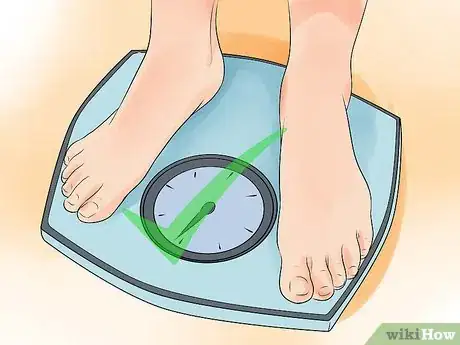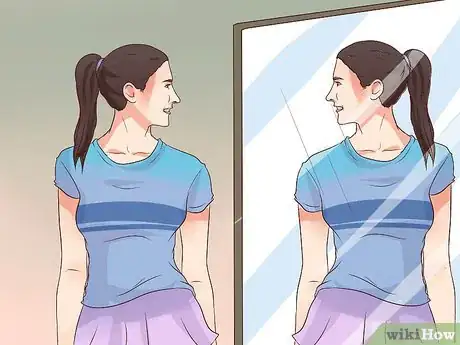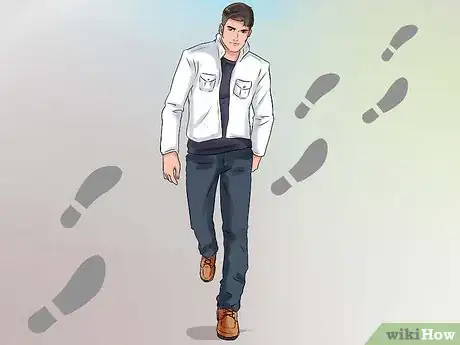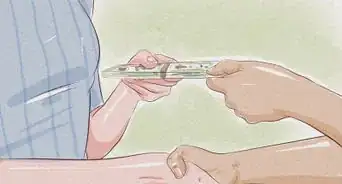This article was co-authored by Melynda Choothesa. Melynda Choothesa is a Costume Designer, Wardrobe Stylist, and Art Director with over 10 years of fashion consulting experience. She has worked on creative direction for fashion shows, costume design, and personal wardrobe styling, both in Los Angeles, California and internationally for clients such as Akon, Kathy Ireland, and Aisha Tyler. She has an Associate of Arts in Fashion Design from Santa Monica College.
There are 13 references cited in this article, which can be found at the bottom of the page.
wikiHow marks an article as reader-approved once it receives enough positive feedback. This article received 39 testimonials and 97% of readers who voted found it helpful, earning it our reader-approved status.
This article has been viewed 465,941 times.
If you're photogenic and enjoy posing for photos, you may have thought about becoming a model. Starting as a teenager is actually very common in the industry -- Tyra Banks began modelling at just 15! It's not an easy field to break into, though, and it's not all glamorous photo shoots and fashion shows. You'll need to be focused, persistent, and hardworking to make it as a model.
Steps
Getting Started as a Model
-
1Do some research. Before you can decide whether modeling is something that you would enjoy or have the necessary qualities for, it helps to familiarize yourself with what the industry requires. It’s important to understand that there are different types of modeling that you might do, such as fashion, plus-size, and commercial, and you may be a better fit for some than others. Figure out what type of modeling that you would like to pursue.[1]
- Fashion models typically walk the runway at designer fashion shows or pose for editorial photo shoots. They are usually at least 5’8”, are thin, and not very curvy.
- Plus-size models are usually at least 5’8” as well, but typically are a size 10 or above. They typically model plus-size clothing and accessories.
- Commercial models pose for everything from print ads to magazines to catalogs. There’s more variety in the size and look in this field of modeling, so you can be shorter than 5’8” and curvy.
- Parts models pose to showcase specific parts of the body, such as their hands or hair. You don’t necessarily have to have a certain body type for this type of modeling as long as the body part in question meets the right criteria.
-
2Be realistic. Like acting and other careers in the entertainment industry, modeling is an extremely competitive business. It’s also based almost entirely on your physical appearance -- if you don’t have the right look, you aren’t going to be able to make a go of it. That means if you have your heart set on being a runway model and you’re only 5’2,” you may want to reconsider. You can’t count on becoming a supermodel either.[2] Most models aren’t paid very much. In fact, the mean hourly wage for models in 2015 was only $17.91 an hour. [3]
- You should pursue modeling if it’s a passion for you, but it’s important to finish school and consider other careers that you might also enjoy.
- If you’re in your early teens and haven’t experienced a major growth spurt yet, you may be better off waiting to pursue modeling until you’re a little older.
Advertisement -
3Talk to your parents. If you’re under 18, you need your parents’ permission to begin modeling, so getting them on board with your plans is key. Explain to them why pursuing a modeling career is important to you. You can help show them how serious you are about by sharing some of the research that you’ve done, such as the type of modeling that you think you’re best suited for. You may also need to reassure them that school will continue to be a priority no matter what happens with your modeling career.[4]
- To help your parents understand why it’s important to you to model, you might say something like, “I think modeling would really help boost my confidence,” or “I feel like modeling would really allow me to express myself.”
- If your parents are opposed to you starting a modeling career, it’s best not to fight them on it. Give them a month or two to get used to the idea, and then try talking to them about it again.
- To reassure them that your school work and other activities won’t suffer as a result of modeling, you might offer to set ground rules with them. For example, you might agree that you’re only allowed to pursue modeling if you maintain a certain GPA in school.
-
4Consider modeling school. If your parents have given you the okay to being a modeling career, you may want to consider taking a modeling class. This type of schooling isn’t necessary to become a model, but it can help you build confidence in front of the camera and get you acquainted with the business side of things. Do an online search for modeling schools and classes in your area to find a good fit.[5]
- Most modeling classes cost money, so you may need to ask your parents to help pay for it. You might offer to do extra chores around the house in exchange for the classes.
- Some modeling schools are scams. Be wary of any that require you to pay additional money for photographs or other add-ons. It’s best to check with the Better Business Bureau, and search for online reviews of the school that you’re considering.
-
5Study magazines. If you don’t want to attend modeling classes and aren’t sure how to pose in front of a camera, it can help to look at other models in actions for inspiration. Look through magazines, catalogs, and print advertisements to get an idea of the types of poses and movements that work well in modeling, so you’ll have some sense of what to do in front of the camera. [6]
- It’s also a good idea to try to recreate some of the looks that you see in magazines and other print materials in front of the mirror. Practice until you feel confident -- and then try to come up with some of your own moves, so you’ll feel more natural and effortless when it is time to pose.
-
6Look for local opportunities. Even if it’s not in a professional capacity, getting some experience as a model can help you build your portfolio and resume. It can also help boost your confidence and make you more comfortable in front of the camera or on the runway. Check around to see if there are any local opportunities for modeling, such as a small business needing models for a print ad or a charity fashion show needing people to walk the runway.[7]
- Getting even minor experience in modeling can also help you decide if it’s really a job that you’re interested in. Make sure that you enjoy the experience before you commit to pursuing modeling seriously.
- You don’t need to get paid as a model for the experience to benefit you. Even if a friend needs a model for a school photography project, take the opportunity to get familiar with the process.
-
7Maintain a healthy weight. Your physical appearance is extremely important when you're a model, so it's important to ensure that you maintain your shape. You don't want to gain -- or lose -- weight and lose your healthy appearance. Depending on the type of modeling that you're doing, your ideal weight may vary, but you should make an effort to eat healthy and exercise regularly.[8]
- Eat a well-balanced diet that includes plenty of fruits and vegetables, whole grains such as oatmeal and brown rice, and protein, including chicken, fish, eggs, beans, and tofu. Avoid foods that are high in saturated fat, trans fat, sodium, and sugar.[9]
- It's also important to drink plenty of water too. 64 ounces a day is a good rule of thumb, but you may need more depending on the weather or how much you're exercising.[10]
- When it comes to exercise, try to find activities that you'll enjoy so you'll stick with them. Running, biking, and swimming are all effective cardio workouts, but you may enjoy taking dance or gymnastics classes. Playing your favorite sports such as soccer, volleyball, or basketball can help keep you fit too.
- Make sure to get plenty of sleep too. While Photoshop can perfect photos, agents typically want to see someone who’s naturally attractive and healthy-looking.
Contacting Agencies
-
1Build a portfolio. Before you can start booking jobs or looking for a modeling agency to represent you, you must create a portfolio of photos. Usually, a model’s portfolio contains pictures of past work, but when you’re just starting out, you likely won’t have any professional shots. If you have the money to pay a professional photographer to take photos, that’s usually the best option. However, you can also have a friend or family member take some shots for you -- just make sure to use a good quality camera and have sufficient lighting.[11]
- Your portfolio should include some headshots, with your face shot from a variety of angles, as well as some full-length photos in fitted clothing.
- You should have a mix of smiling and straight face shots to provide a range of looks.
- In some shots, it’s also a good idea to go for a natural look with no makeup so booking agents will have an idea what you look like when you’re not all made up.
- There should also be a page in your portfolio with your stats. Include hair color, eye color, height, weight, and other measurements.
-
2Find an “open call.” If you live in a big city, such as New York, Los Angeles, Chicago, Dallas, Miami, or San Francisco, it’s best to call major modeling agencies and see if they’re holding an “open call,” which is an event where they invite potential models in for a consultation. That’s because you get to meet casting agents in person, so you can make an impression with your personality in addition to your looks. If you don’t live in a major city, contact agencies in the closest city and see if they work with any smaller agencies in your area.[12]
- Make sure to do research on the agencies that you contact to ensure that they’re reputable.
- You’ll need to bring your portfolio to your open call. If you haven’t put together a portfolio yet, make sure to have at least a few photos that you can bring to show your range.
-
3Submit your portfolio. You don’t necessarily have to wait for an open call to contact modeling agencies. Instead, you can send your portfolio and let the photos do the talking for you. Visit the websites of the agencies that you’re interested in, and see what their procedure is for submitting a portfolio. Some will allow you to do it online, while others will ask that you mail a hard copy.[13]
- If you’re mailing a copy of your portfolio, don’t forget to include your contact information, so the agency can get in touch with you if they’re interested.
Meeting with an Agent
-
1Act professionally. If you’re lucky enough to score a meeting with an agent, it’s important to show that you understand that modeling is a business and will act professionally. That means you must be on time and prepared for the appointment.[14] You shouldn’t be rearranging your portfolio in the elevator on your way up to the office -- it should be ready to go the day before. It’s also important to make a good first impression, so dress appropriately too.[15]
- Your portfolio isn’t the only thing that you should bring to your meeting. Some modeling agencies may want to see more casual shots as well, so you may want to bring a few candid snapshots or Polaroids with you as well.
- A modeling agent wants to see the real you, so wear little to no makeup and keep your hair natural.
- You don’t have to show up to your meeting in fancy clothes, such as a gown or suit. Casual clothing works well, but make sure that it fits well. A pair of skinny jeans and a fitted tank top or t-shirt make an ideal outfit.
- It’s a good idea to read up on the agency that you’re meeting with before your appointment. Learn what models they’re currently working with and who they’ve worked with in the past, so you have a better feel for the company.
-
2Showcase your personality. Your looks aren’t the only thing that are going to impress modeling agents -- they want to see that you have a fun, engaging personality as well. The best models are confident and can express themselves easily, so speak your mind at the meeting without being rude or unprofessional.[16]
- Agents want to be sure that you are genuinely interested in modeling and not just being pushed into it by your parents or others. Make sure to convey your passion for being a model. You might say, “I really love the opportunity that modeling provides to express myself,” or “I never feel more confident than when I’m in front of the camera or walking down the runway.”
-
3Use the right body language. When you're meeting with modeling agents, you don't want to appear nervous or self-conscious. That's why your body language is so important. Stand and sit up straight and hold your head up high to look more sure of yourself. It also helps to maintain eye contact and smile throughout your meeting too.[17]
- Try to limit nervous gestures, such as bouncing your feet, fidgeting with your hair, or tapping your fingers on the desk or table. Staying still and relaxed projects a more confident image.
- Try to avoid crossing your arms over your chest. It can make you appear defensive.
-
4Prepare yourself for rejection. Because modeling is such a competitive industry, chances are good that you’re going to hear many no’s as you try to land jobs or an agent. You have to learn not to take it personally -- sometimes, you just don’t have the look that’s required for a particular campaign. Even successful supermodels have been rejected at one point or another.
- Remind yourself that you have to have plenty of persistence and determination if you’re going to make it as a model.
-
5Be careful when signing a contract. Having a modeling agency offer you a contract is very exciting. However, if you’re under 18, your parents are usually legally required to sign the contract on your behalf. They should definitely read it over before signing it, and they may even want a lawyer to take a look at it. Make sure that you understand everything that’s in the contract as well -- it is your career after all.[18]
- Don’t be afraid to ask questions about the contract -- to your parents or your agent. It’s important that you’re clear on all of the details.
Community Q&A
-
QuestionWhat if people tell me I can be a model but I don't think I'm pretty or photogenic enough?
 Community AnswerWell, you don't know until you try. Everyone is beautiful in some way, and people are often hardest on themselves, so if you want to be a model, you should go for it.
Community AnswerWell, you don't know until you try. Everyone is beautiful in some way, and people are often hardest on themselves, so if you want to be a model, you should go for it. -
QuestionI would like to be a model but I'm 12. Are their modeling jobs for 12-year-olds?
 Community AnswerThere are probably commercial modeling jobs for 12 year olds because catalogs need children to model clothing and other items. Print advertisements also require children.
Community AnswerThere are probably commercial modeling jobs for 12 year olds because catalogs need children to model clothing and other items. Print advertisements also require children. -
QuestionWhat if you don't have the money for the portfolio?
 Community AnswerYou don't necessarily have to have photos taken by a professional photographer. Have a friend or family member take some photos of you -- just make sure that you use the best quality camera that you have access to, and the lighting is good. Some modeling agencies allow you to submit photos online, so you don't even have to have hard copies made.
Community AnswerYou don't necessarily have to have photos taken by a professional photographer. Have a friend or family member take some photos of you -- just make sure that you use the best quality camera that you have access to, and the lighting is good. Some modeling agencies allow you to submit photos online, so you don't even have to have hard copies made.
References
- ↑ http://www.collegefashion.net/fashion-tips/models-101-how-to-start-your-modeling-career/
- ↑ http://www.teenvogue.com/story/how-to-get-started-in-modeling
- ↑ http://www.bls.gov/oes/current/oes419012.htm
- ↑ http://www.seventeen.com/fashion/style-advice/tips/a19348/todd-anthony-tyler-breaking-modeling-industry/
- ↑ http://www.marieclaire.com/fashion/advice/g740/how-to-model/?slide=2
- ↑ http://www.marieclaire.com/fashion/advice/g740/how-to-model/?slide=2
- ↑ https://www.theartcareerproject.com/become/fashion-model/
- ↑ http://www.seventeen.com/fashion/style-advice/tips/a19348/todd-anthony-tyler-breaking-modeling-industry/
- ↑ http://girlshealth.gov/nutrition/healthy_eating/index.html
- ↑ http://news.health.com/2015/09/16/the-amount-of-water-you-actually-need-per-day/
- ↑ http://www.collegefashion.net/fashion-tips/models-101-how-to-start-your-modeling-career/
- ↑ http://www.teenvogue.com/story/how-to-get-started-in-modeling
- ↑ http://www.collegefashion.net/fashion-tips/models-101-how-to-start-your-modeling-career/
- ↑ Melynda Choothesa. Professional Stylist & Fashion Designer. Expert Interview. 17 April 2019.
- ↑ http://www.marieclaire.com/fashion/advice/g740/how-to-model/?slide=4
- ↑ http://www.marieclaire.com/fashion/advice/g740/how-to-model/?slide=6
- ↑ http://www.forbes.com/sites/carolkinseygoman/2013/08/21/12-body-language-tips-for-career-success/#4469ac652a13
- ↑ http://www.marieclaire.com/fashion/advice/g740/how-to-model/?
About This Article
To become a teen model, do some research to see what kind of modelling is best for your interests and body type. For example, fashion models are generally at least 5' 8" tall and thin while commercial models are more diverse. Once you decide which type of modelling is right for you, talk to your parents about your plans because you'll need their permission. Look online to enroll in modeling schools in your area and practice being photographed. Pursue local opportunities to model, even if they are unpaid, so you can start building a portfolio. For advice from our reviewer about building your portfolio, read on!
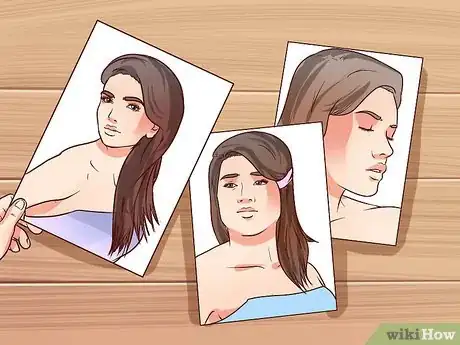
-Step-1-Version-3.webp)



